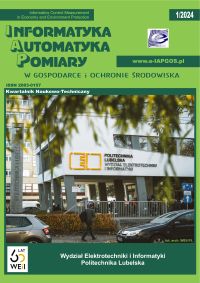RUNNING A WORKFLOW WITHOUT WORKFLOWS: A BASIC ALGORITHM FOR DYNAMICALLY CONSTRUCTING AND TRAVERSING AN IMPLIED DIRECTED ACYCLIC GRAPH IN A NON-DETERMINISTIC ENVIRONMENT
Article Sidebar
Open full text
Issue Vol. 14 No. 1 (2024)
-
SOME MORE ON LOGARITHMIC SINGULARITY INTEGRATION IN BOUNDARY ELEMENT METOD
Tomasz Rymarczyk, Jan Sikora5-10
-
ЕLECTROMAGNETIC FIELD EQUATIONS IN NONLINEAR ENVIRONMENT
Viktor Lyshuk, Vasyl Tchaban, Anatolii Tkachuk, Valentyn Zablotskyi, Yosyp Selepyna11-16
-
OPTICAL SPECKLE-FIELD VISIBILITY DIMINISHING BY REDUCTION OF A TEMPORAL COHERENCE
Mikhaylo Vasnetsov, Valeriy Voytsekhovich, Vladislav Ponevchinsky, Nataliia Kachalova, Alina Khodko, Oleksanr Mamuta, Volodymyr Pavlov, Vadym Khomenko, Natalia Manicheva17-20
-
QUALITY INDICATORS OF DETECTION OF SIDE RADIATION SIGNALS FROM MONITOR SCREENS BY A SPECIALIZED TECHNICAL MEANS OF ENEMY INTELLIGENCE
Dmytro Yevgrafov, Yurii Yaremchuk21-26
-
THE IMPACT OF LIGHTNING STRIKE ON HYBRID HIGH VOLTAGE OVERHEAD TRANSMISSION LINE – INSULATED GAS LINE
Samira Boumous, Zouhir Boumous, Yacine Djeghader27-31
-
ENERGY EFFICIENCY OF PHOTOVOLTAIC PANELS DEPENDING ON THE STEP RESOLUTION OF TRACKING SYSTEM
Kamil Płachta32-36
-
DIGITAL IMAGE RESTORATION USING SURF ALGORITHM
Shanmukhaprasanthi Tammineni, Swaraiya Madhuri Rayavarapu, Sasibhushana Rao Gottapu, Raj Kumar Goswami37-40
-
TENSOR AND VECTOR APPROACHES TO OBJECTS RECOGNITION BY INVERSE FEATURE FILTERS
Roman Kvуetnyy, Yuriy Bunyak, Olga Sofina, Volodymyr Kotsiubynskyi, Tetiana Piliavoz, Olena Stoliarenko, Saule Kumargazhanova41-45
-
ARCHITECTURAL AND STRUCTURAL AND FUNCTIONAL FEATURES OF THE ORGANIZATION OF PARALLEL-HIERARCHICAL MEMORY
Leonid Timchenko, Natalia Kokriatska, Volodymyr Tverdomed, Iryna Yepifanova, Yurii Didenko, Dmytro Zhuk, Maksym Kozyr, Iryna Shakhina46-52
-
SIMULATION AND COMPUTER MODELING OF BRIDGE STRUCTURES DYNAMICS USING ANSYS
Anzhelika Stakhova, Adrián Bekö53-56
-
ENHANCING CROP HEALTH THROUGH DIGITAL TWIN FOR DISEASE MONITORING AND NUTRIENT BALANCE
Sobhana Mummaneni, Tribhuvana Sree Sappa, Venkata Gayathri Devi Katakam57-62
-
REVIEW OF MODELLING APPROACHES FOR WEBSITE-RELATED PREDICTIONS
Patryk Mauer63-66
-
FORMATION OF HIGHLY SPECIALIZED CHATBOTS FOR ADVANCED SEARCH
Andrii Yarovyi, Dmytro Kudriavtsev67-70
-
METHOD FOR CALCULATING THE INFORMATION SECURITY INDICATOR IN SOCIAL MEDIA WITH CONSIDERATION OF THE PATH DURATION BETWEEN CLIENTS
Volodymyr Akhramovych, Yuriy Pepa, Anton Zahynei, Vadym Akhramovych, Taras Dzyuba, Ihor Danylov71-77
-
CORRESPONDENCE MATCHING IN 3D MODELS FOR 3D HAND FITTING
Maksym Tymkovych, Oleg Avrunin, Karina Selivanova, Alona Kolomiiets, Taras Bednarchyk, Saule Smailova78-82
-
GENETIC ALGORITHM-BASED DECISION TREE OPTIMIZATION FOR DETECTION OF DEMENTIA THROUGH MRI ANALYSIS
Govada Anuradha, Harini Davu, Muthyalanaidu Karri83-89
-
MEDICAL FUZZY-EXPERT SYSTEM FOR PREDICTION OF ENGRAFTMENT DEGREE OF DENTAL IMPLANTS IN PATIENTS WITH CHRONIC LIVER DISEASE
Vitaliy Polishchuk, Sergii Pavlov, Sergii Polishchuk, Sergii Shuvalov, Andriy Dalishchuk, Natalia Sachaniuk-Kavets’ka, Kuralay Mukhsina, Abilkaiyr Nazerke90-94
-
ROOT SURFACE TEMPERATURE MEASUREMENT DURING ROOT CANAL OBTURATION
Les Hotra, Oksana Boyko, Igor Helzhynskyy, Hryhorii Barylo, Pylyp Skoropad, Alla Ivanyshyn, Olena Basalkevych95-98
-
EVALUATING THE FEASIBILITY OF THERMOGRAPHIC IMAGES FOR PREDICTING BREAST TUMOR STAGE USING DCNN
Zakaryae Khomsi, Mohamed El Fezazi, Achraf Elouerghi, Larbi Bellarbi99-104
-
A COMPREHENSIVE STUDY: INTRACRANIAL ANEURYSM DETECTION VIA VGG16-DENSENET HYBRID DEEP LEARNING ON DSA IMAGES
Sobhana Mummaneni, Sasi Tilak Ravi, Jashwanth Bodedla, Sree Ram Vemulapalli, Gnana Sri Kowsik Varma Jagathapurao105-110
-
DEFORMATIONS OF SOIL MASSES UNDER THE ACTION OF HUMAN-INDUCED FACTORS
Mykola Kuzlo, Viktor Moshynskyi, Nataliia Zhukovska, Viktor Zhukovskyy111-114
-
RUNNING A WORKFLOW WITHOUT WORKFLOWS: A BASIC ALGORITHM FOR DYNAMICALLY CONSTRUCTING AND TRAVERSING AN IMPLIED DIRECTED ACYCLIC GRAPH IN A NON-DETERMINISTIC ENVIRONMENT
Fedir Smilianets, Oleksii Finogenov115-118
-
INTELLIGENT DATA ANALYSIS ON AN ANALYTICAL PLATFORM
Dauren Darkenbayev, Arshyn Altybay, Zhaidargul Darkenbayeva, Nurbapa Mekebayev119-122
Archives
-
Vol. 15 No. 3
2025-09-30 24
-
Vol. 15 No. 2
2025-06-27 24
-
Vol. 15 No. 1
2025-03-31 26
-
Vol. 14 No. 4
2024-12-21 25
-
Vol. 14 No. 3
2024-09-30 24
-
Vol. 14 No. 2
2024-06-30 24
-
Vol. 14 No. 1
2024-03-31 23
-
Vol. 13 No. 4
2023-12-20 24
-
Vol. 13 No. 3
2023-09-30 25
-
Vol. 13 No. 2
2023-06-30 14
-
Vol. 13 No. 1
2023-03-31 12
-
Vol. 12 No. 4
2022-12-30 16
-
Vol. 12 No. 3
2022-09-30 15
-
Vol. 12 No. 2
2022-06-30 16
-
Vol. 12 No. 1
2022-03-31 9
-
Vol. 10 No. 4
2020-12-20 16
-
Vol. 10 No. 3
2020-09-30 22
-
Vol. 10 No. 2
2020-06-30 16
-
Vol. 10 No. 1
2020-03-30 19
Main Article Content
DOI
Authors
Abstract
This paper introduces a novel algorithm for dynamically constructing and traversing Directed Acyclic Graphs (DAGs) in workflow systems, particularly targeting distributed computation and data processing domains. Traditional workflow management systems rely on explicitly defined, rigid DAGs, which can be cumbersome to maintain, especially in response to frequent changes or updates in the system. Our proposed algorithm circumvents the need for explicit DAG construction, instead opting for a dynamic approach that iteratively builds and executes the workflow based on available data and operations, through a combination of entities like Data Kinds, Operators, and Data Units, the algorithm implicitly forms a DAG, thereby simplifying the process of workflow management. We demonstrate the algorithm’s functionality and assess its performance through a series of tests in a simulated environment. The paper discusses the implications of this approach, especially focusing on cycle avoidance and computational complexity, and suggests future enhancements and potential applications.
Keywords:
References
Brewer L. E. et al.: Causal inference in cumulative risk assessment: The roles of directed acyclic graphs. Environment International 102, 2017, 30–41 [https://doi.org/https://doi.org/10.1016/j.envint.2016.12.005]. DOI: https://doi.org/10.1016/j.envint.2016.12.005
Colonnelli I. et al.: Bringing AI pipelines onto cloud-HPC: setting a baseline for accuracy of COVID-19 diagnosis. ENEA CRESCO in the Fight Against COVID-19, 2021, 66–73 [https://doi.org/10.5281/ZENODO.5151511].
Eugster P. Th. et al.: The many faces of publish/subscribe. ACM Comput. Surv. 35(2), 2003, 114–131. DOI: https://doi.org/10.1145/857076.857078
Ferguson K. D. et al.: Evidence synthesis for constructing directed acyclic graphs (ESC-DAGs): a novel and systematic method for building directed acyclic graphs. International Journal of Epidemiology 49(1), 2019, 322–329 [https://doi.org/10.1093/ije/dyz150]. DOI: https://doi.org/10.1093/ije/dyz150
Georgeson P. et al.: Bionitio: demonstrating and facilitating best practices for bioinformatics command-line software. GigaScience 8(9), 2019, giz109 [https://doi.org/10.1093/gigascience/giz109]. DOI: https://doi.org/10.1093/gigascience/giz109
Jackson M. et al.: Using prototyping to choose a bioinformatics workflow management system. PLOS Computational Biology 17(2), 2021. DOI: https://doi.org/10.1371/journal.pcbi.1008622
Article Details
Abstract views: 269







